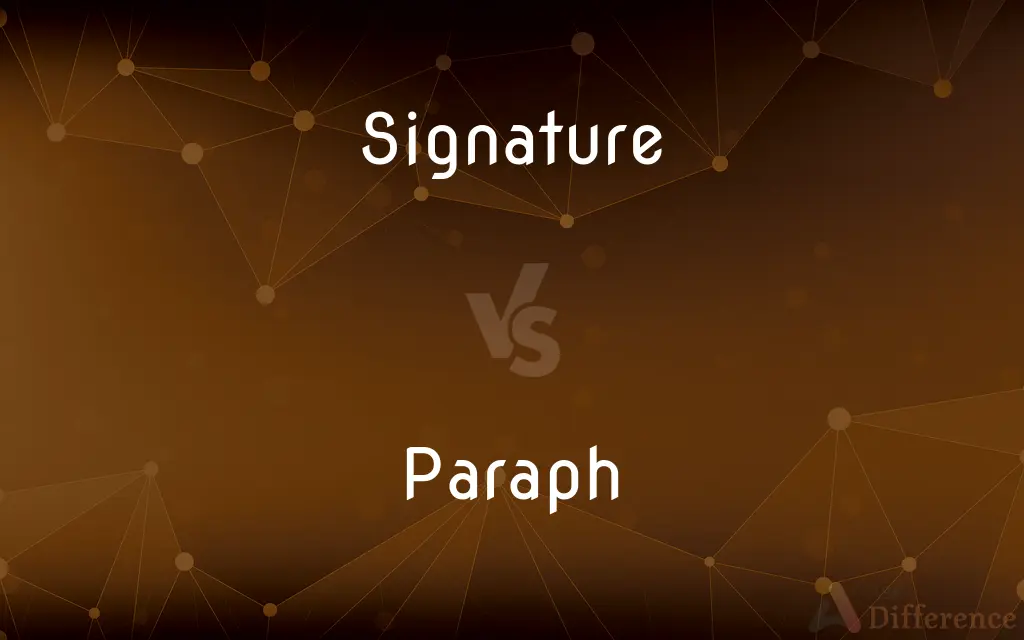Signature vs. Paraph — What's the Difference?
By Tayyaba Rehman & Urooj Arif — Updated on March 25, 2024
A signature is a person's name written in their unique style, used for authorization, while a paraph is a flourish added to a signature for added security.

Difference Between Signature and Paraph
Table of Contents
ADVERTISEMENT
Key Differences
A signature represents an individual's unique way of writing their name or initials, which serves as a form of identification and consent in legal and financial documents. It's a personal mark that legally binds an individual to the terms of a document, ensuring authenticity and intent. On the other hand, a paraph is a distinctive flourish or mark that an individual adds to their signature. This additional element is meant to enhance the uniqueness of the signature, making it more difficult to forge and thereby increasing the security of the document.
Signatures have been used for centuries as a way for individuals to authorize documents, agreements, and transactions. They can vary greatly from person to person, sometimes including full names, initials, or a combination of both. In contrast, paraphs are not universal but are a personalized addition that some individuals choose to incorporate with their signature. The paraph can take many forms, such as loops or lines, and is often used in legal, financial, and high-security contexts.
The legal significance of a signature lies in its capacity to demonstrate the signer's agreement and acknowledgment of the contents of a document. It's a universally recognized practice that provides a level of legal protection and accountability. Paraphs, while not legally required, serve as an extra layer of security. By making a signature more complex and unique, a paraph helps to prevent unauthorized copies and forgeries, offering an additional safeguard against fraud.
While the signature itself is a requirement on many types of documents, the paraph is optional. Individuals may decide to use a paraph based on the level of security they wish to associate with their signature. As such, signatures without paraphs are still valid but may be considered less secure in certain contexts. Paraphs, therefore, are a personal choice that reflect an individual’s desire for increased security and individuality in their legal and financial documents.
In terms of recognition and enforceability, both signatures and paraphs are subject to legal scrutiny. However, the signature is the primary element that is legally binding. The paraph, while enhancing security, does not independently carry legal weight but works in tandem with the signature to verify the signer's identity and intent. The combination of a signature and a paraph can provide a stronger evidence of authenticity and consent in legal proceedings.
ADVERTISEMENT
Comparison Chart
Definition
A person's name written in a unique style for authorization.
A distinctive flourish added to a signature for added security.
Purpose
Identification, consent, and legal authorization.
Enhancing signature uniqueness and security against forgery.
Legal Significance
Legally binding, demonstrating agreement to document terms.
Not independently legally binding but adds to signature security.
Variability
Can vary widely among individuals.
Personalized and optional, varies even more widely.
Use in Documents
Required on legal, financial, and official documents.
Optional, used for added security in high-risk contexts.
Compare with Definitions
Signature
Essential for document verification.
The bank requires a signature for all transactions.
Paraph
Optional but enhances document safety.
Adding a paraph is a wise choice for important documents.
Signature
Legal binding of an individual to a document.
The contract is effective upon your signature.
Paraph
Used in high-security contexts.
Officials often use a paraph in legal documents.
Signature
A person's handwritten name for authorization.
Please ensure your signature matches the one on your ID.
Paraph
A flourish added to a signature for security.
Her paraph made her signature difficult to forge.
Signature
Varied in style and form.
His signature is almost illegible but unique.
Paraph
Personalizes and secures signatures.
The paraph alongside her signature is a trademark of her legal documents.
Signature
Personal identification mark.
Artists often include their signature on their works.
Paraph
Varies greatly among individuals.
His paraph is a series of elaborate loops.
Signature
A signature (; from Latin: signare, "to sign") is a handwritten (and often stylized) depiction of someone's name, nickname, or even a simple "X" or other mark that a person writes on documents as a proof of identity and intent. The writer of a signature is a signatory or signer.
Paraph
A flourish made after or below a signature, originally to prevent forgery.
Signature
A person's name written in a distinctive way as a form of identification in authorizing a cheque or document or concluding a letter
The signature of a senior manager
Paraph
A flourish made after or below one's signature, originally to prevent forgery.
Signature
Short for key signature or time signature
Paraph
A mark used by medieval rubricators to indicate textual division.
Signature
A letter or figure printed at the foot of one or more pages of each sheet of a book as a guide in binding.
Paraph
(transitive) To add a paraph to; to sign, especially with one's initials.
Signature
The part of a medical prescription that gives instructions about the use of the medicine or drug prescribed.
Paraph
A flourish made with the pen at the end of a signature. In the Middle Ages, this formed a sort of rude safeguard against forgery.
Signature
One's name as written by oneself.
Paraph
To add a paraph to; to sign, esp. with the initials.
Signature
The act of signing one's name.
Paraph
A flourish added after or under your signature (originally to protect against forgery)
Signature
See e-signature.
Signature
A distinctive mark, characteristic, or sound indicating identity
A surprise ending is the signature of an O. Henry short story.
Signature
(Medicine) The part of a physician's prescription containing directions to the patient.
Signature
A sign used to indicate key.
Signature
A sign used to indicate tempo.
Signature
A letter, number, or symbol placed at the bottom of the first page on each sheet of printed pages of a book as a guide to the proper sequence of the sheets in binding.
Signature
A large sheet printed with four or a multiple of four pages that when folded becomes a section of the book.
Signature
See chemical signature.
Signature
A person's name, written by that person, used as identification or to signify approval of accompanying material, such as a legal contract.
Signature
An act of signing one's name; an act of producing a signature.
Signature
(medicine) The part of a doctor’s prescription containing directions for the patient.
Signature
(music) Signs on the stave indicating key and tempo, composed of the key signature and the time signature.
Signature
(printing) A group of four (or a multiple of four) sheets printed such that, when folded, they become a section of a book.
Signature
(computing) A pattern used for matching the identity of a virus, the parameter types of a method, etc.
Signature
(cryptography) Data attached to a message that guarantees that the message originated from its claimed source.
Signature
(figurative) A mark or sign of implication.
Signature
A dish that is characteristic of a particular chef.
Signature
(mathematics) A tuple specifying the sign of coefficients in any diagonal form of a quadratic form.
Signature
A resemblance between the external character of a disease and those of some physical agent, for instance, that existing between the red skin of scarlet fever and a red cloth; supposed to indicate this agent in the treatment of the disease.
Signature
(internet) Text (or images, etc.) appended to a user's emails, newsgroup posts, forum posts, etc. as a way of adding a personal touch or including contact details.
Your signature must not exceed three lines of text, or 600 pixels in height.
Forum signature generator
Signature
Distinctive, characteristic, indicative of identity.
Rabbit in mustard sauce is my signature dish.
The signature route of the airline is its daily flight between Buenos Aires and Madrid.
Signature
A sign, stamp, or mark impressed, as by a seal.
The brain, being well furnished with various traces, signatures, and images.
The natural and indelible signature of God, which human souls . . . are supposed to be stamped with.
Signature
Especially, the name of any person, written with his own hand, employed to signify that the writing which precedes accords with his wishes or intentions; a sign manual; an autograph.
Signature
An outward mark by which internal characteristics were supposed to be indicated.
Some plants bear a very evident signature of their nature and use.
Signature
A resemblance between the external characters of a disease and those of some physical agent, for instance, that existing between the red skin of scarlet fever and a red cloth; - supposed to indicate this agent in the treatment of the disease.
Signature
The designation of the key (when not C major, or its relative, A minor) by means of one or more sharps or flats at the beginning of the staff, immediately after the clef, affecting all notes of the same letter throughout the piece or movement. Each minor key has the same signature as its relative major.
Signature
A letter or figure placed at the bottom of the first page of each sheet of a book or pamphlet, as a direction to the binder in arranging and folding the sheets.
Signature
That part of a prescription which contains the directions to the patient. It is usually prefaced by S or Sig. (an abbreviation for the Latin signa, imperative of signare to sign or mark).
Signature
To mark with, or as with, a signature or signatures.
Signature
Your name written in your own handwriting
Signature
A distinguishing style;
This room needs a woman's touch
Signature
A melody used to identify a performer or a dance band or radio/tv program
Signature
The sharps or flats that follow the clef and indicate the key
Signature
A sheet with several pages printed on it; it folds to page size and is bound with other signatures to form a book
Common Curiosities
What is the main purpose of a signature?
To provide identification, consent, and legal authorization on documents.
Can a signature without a paraph be secure?
Yes, though a paraph adds an extra layer of security, a signature alone is still legally binding and secure.
How does a paraph enhance a signature?
By adding a unique flourish, it increases the signature's security against forgery.
How do you create a paraph?
It's a personal flourish or mark that you consistently add to your signature.
Are all paraphs the same?
No, paraphs vary greatly among individuals, adding to their security feature.
How important is consistency in signatures and paraphs?
Consistency is crucial for verification purposes and to prevent unauthorized use.
What happens if a signature is forged on a document?
Forged signatures can invalidate a document and lead to legal consequences for the forger.
Is a paraph legally required for a signature to be valid?
No, a paraph is optional and not legally required for signature validity.
Does the presence of a paraph affect the legal standing of a document?
The paraph itself doesn’t change the document's legal standing but enhances the signature’s security.
What documents typically require a signature?
Legal, financial, and official documents often require a signature for validation.
Can electronic signatures include paraphs?
Yes, electronic signatures can include paraphs if the digital format allows for such personalization.
Are there guidelines for creating a paraph?
While there are no strict guidelines, a paraph should be distinctive yet consistent with your signature.
Can a paraph be legally binding on its own?
No, a paraph is not independently legally binding without the accompanying signature.
What should individuals consider when adding a paraph to their signature?
They should consider the balance between complexity (for security) and the ability to consistently reproduce the paraph.
How can someone verify the authenticity of a signature and paraph?
Through comparison with verified samples or forensic analysis by experts.
Share Your Discovery

Previous Comparison
Erg vs. Reg
Next Comparison
Column vs. StiltAuthor Spotlight
Written by
Tayyaba RehmanTayyaba Rehman is a distinguished writer, currently serving as a primary contributor to askdifference.com. As a researcher in semantics and etymology, Tayyaba's passion for the complexity of languages and their distinctions has found a perfect home on the platform. Tayyaba delves into the intricacies of language, distinguishing between commonly confused words and phrases, thereby providing clarity for readers worldwide.
Co-written by
Urooj ArifUrooj is a skilled content writer at Ask Difference, known for her exceptional ability to simplify complex topics into engaging and informative content. With a passion for research and a flair for clear, concise writing, she consistently delivers articles that resonate with our diverse audience.
















































